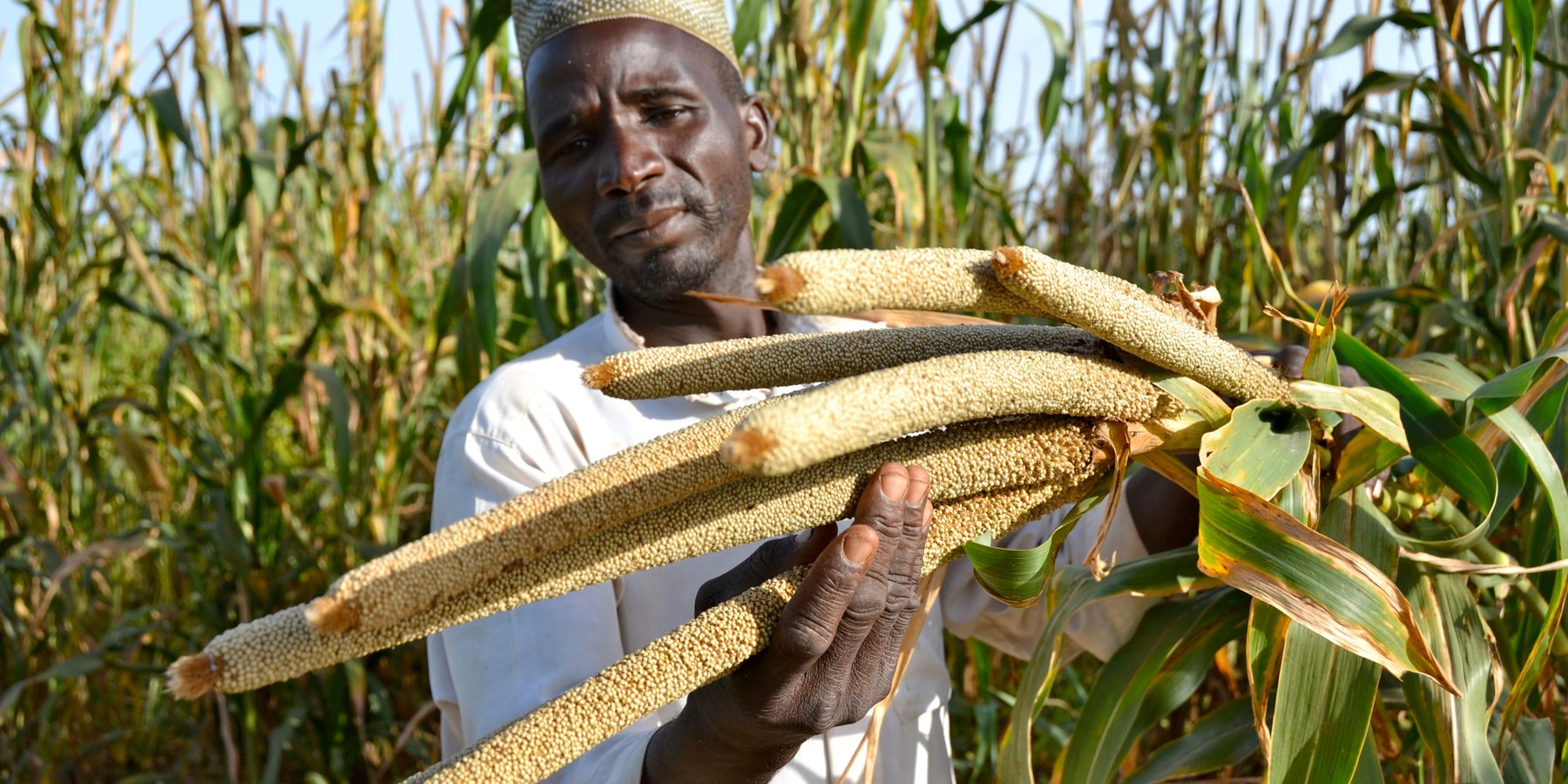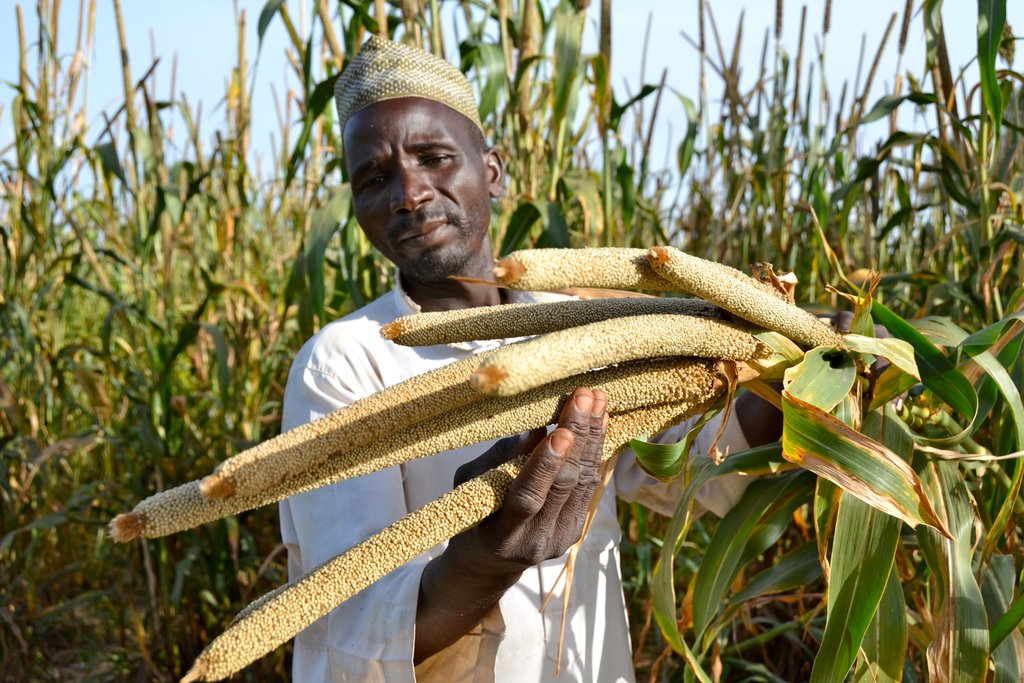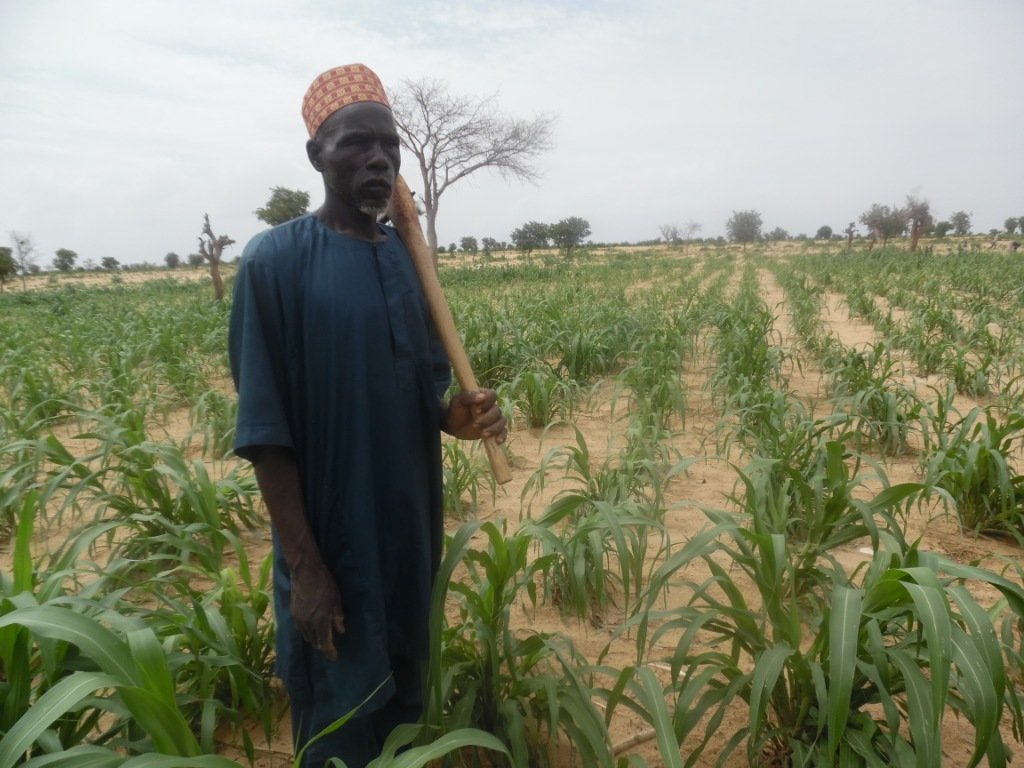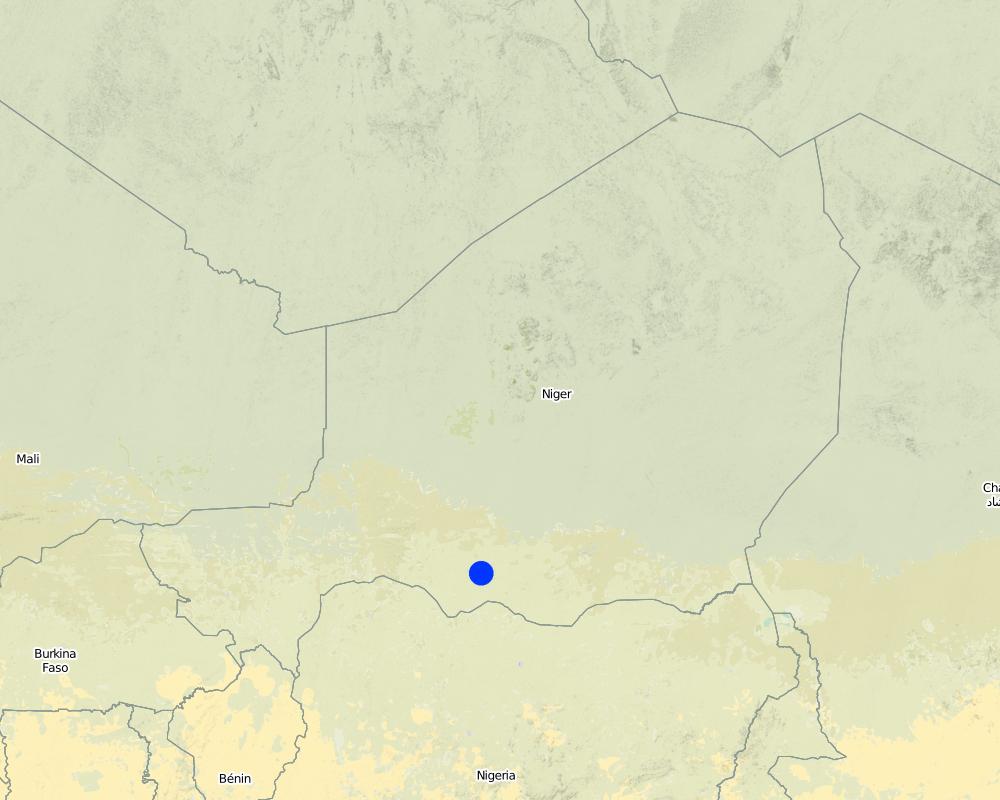Improved millet variety HKP [Niger]
- Creation:
- Update:
- Compiler: Judith Macchi
- Editors: RABO ISSAKA SALISSOU, Christine Lottje
- Reviewers: Christine Lottje, David Beritault, Alexandra Gavilano
Yada irin hatsi mai nagarta HKP cikin jahar Mayahi
technologies_661 - Niger
- Full summary as PDF
- Full summary as PDF for print
- Full summary in the browser
- Full summary (unformatted)
- Diffusion de la variété améliorée du mil HKP dans le département de Mayahi: Aug. 9, 2017 (inactive)
- Improved millet variety HKP: Dec. 6, 2017 (public)
- Improved millet variety HKP: Oct. 31, 2017 (inactive)
- Diffusion de la variété améliorée du mil HKP dans le département de Mayahi: March 14, 2017 (inactive)
- Diffusion de la variété améliorée du mil HKP dans le département de Mayahi: Feb. 20, 2017 (inactive)
View sections
Expand all Collapse all1. General information
1.2 Contact details of resource persons and institutions involved in the assessment and documentation of the Technology
Key resource person(s)
SLM specialist:
Ibrahim Baoua
96970190 / 90423573
baoua.ibrahim@yahoo.fr
Cabinet Sahel Bio
Maradi/Grand marché
Niger
land user:
Souley Anné
96607687
Mayahi/Maitsakoni
Niger
land user:
Sani Sabo
92398978
Mayahi/Maitsakoni
Niger
Name of project which facilitated the documentation/ evaluation of the Technology (if relevant)
Book project: where people and their land are safer - A Compendium of Good Practices in Disaster Risk Reduction (DRR) (where people and their land are safer)Name of the institution(s) which facilitated the documentation/ evaluation of the Technology (if relevant)
HEKS (Hilfswerk der Evangelischen Kirchen Schweiz) (HEKS (Hilfswerk der Evangelischen Kirchen Schweiz)) - Switzerland1.3 Conditions regarding the use of data documented through WOCAT
When were the data compiled (in the field)?
11/10/2016
The compiler and key resource person(s) accept the conditions regarding the use of data documented through WOCAT:
Yes
1.4 Declaration on sustainability of the described Technology
Is the Technology described here problematic with regard to land degradation, so that it cannot be declared a sustainable land management technology?
No
1.5 Reference to Questionnaire(s) on SLM Approaches
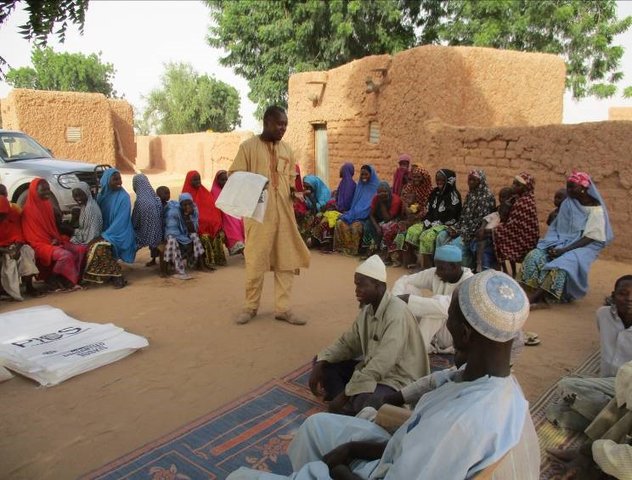
Training and awareness raising in the use of … [Niger]
This approach consists of disseminating improved agricultural techniques to increase the agricultural production. Producers are trained to demonstrate the techniques, and demonstration events are organised to make other producers aware of the use of these improved techniques.
- Compiler: Judith Macchi
2. Description of the SLM Technology
2.1 Short description of the Technology
Definition of the Technology:
The millet variety HKP, "Haini Kire Précoce" in Djerma language (finger millet in English), is a high-yielding millet variety, adapted to the Sahelian context
2.2 Detailed description of the Technology
Description:
As in all of Niger, the department of Mayahi in the southern central part of the country is characterized by a harsh natural environment with low precipitation, which is variable in space and time, and high temperatures, with a tendency to increase even more due to the effects of climate change, increasing the aridity of the region. With 3,1%, the population is growth is very high. The pressure on the natural resources has also strongly increased, and the chronic food insecurity regularly affects the majority of the population.
Millet and cowpea are the main agricultural products of the region, but due to the demographic pressure, the arable land is practically entirely in use. Consequently, food security can only be achieved through an increased production.
Millet (Pennisetum glaucum (L.) R.Br) is grown in several countries in West Africa, among which Niger, Nigeria and Burkina Faso. Millet is the most cultivated cereal crop and is most consumed in Niger, while the stalk is appetizing for grazing animals and serves as construction material for houses.
The millet variety HPK was developed in 1978 by the National Agronomic Research Institute of Niger (INRAN) with the aim to grow a better performing variety, more adapted to the Sahelian context. The variety HKP is resistant to drought, not very sensitive to worms, slightly sensitive to the photoperiod, but sensitive to smut and mildew. Unfortunately this variety at present is still in the stage of dissemination. This delay is explained by the difficulties in the technical management of the Nigerian seed system, and the difficult access for local producers. Yet, in the ten past years a significant advance is noted in the adoption of improved seed by the farmers who became aware that the reality of climate change requires better performing varieties.
The agro-ecological zone of the millet variety HPK is comprised between the 350 and 800 mm isohyets. It can be cultivated as a mono-culture, or in association with other crops like cowpea, sorghum, or peanut. The crop cycle takes between 75 and 90 days. Millet is preferably grown on light soils rich in organic matter. The preparation of the seed bed requires an amendment of 3 to 5 tons of decomposed organic matter per hectare and scarification with a Canadian cultivator (3 or 5 blades) after the first rains to bury the organic matter. The best period for sowing is June. Ten kilos of seed are required to sow one hectare. The spacing for the seeds is 1 m x 1 m between the pockets and the lines, or 10.000 pockets per hectare. The seed can be combined with a micro-dose of mineral fertiliser of 6 g/pocket (60 kg/ha) for the 15-15-15 fertiliser and 2 g/pocket (20 kg/ha) for the DAP. The field maintenance activities must be done in time. These include two operations of weeding and harrowing ('sarclo-binage'), while thinning out until three plants per pocket in the first operation, two weeks after seeding at the latest; the second operation of weeding and harrowing is two or three weeks after the first. A cover of urea manure is applied two times on the pocket (for the southern zone: 50 kg/ha in the tillering phase and 50 kg/ha at stem formation; for the intermediate zone: 25 kg/ha in the tillering phase and 25 kg/ha at stem formation). One or two treatments are expected in case of mildew. If not, the plants affected by the mildew and the leaf miner must be torn out, burnt and buried into the soil. The harvest is done when the ears are completely mature and dry. The variety HKP has a potential yield of 1,5 to 2,5 tons per hectare. The millet can be conserved in a granary or in a bag after treshing. The producers appreciate the good emergence of the crop, its earliness and its yield.
2.3 Photos of the Technology
2.5 Country/ region/ locations where the Technology has been applied and which are covered by this assessment
Country:
Niger
Region/ State/ Province:
Maradi
Further specification of location:
Mayayi
Map
×2.6 Date of implementation
Indicate year of implementation:
2014
2.7 Introduction of the Technology
Specify how the Technology was introduced:
- during experiments/ research
- through projects/ external interventions
Comments (type of project, etc.):
The Zamtapo project has distributed improved seeds of millet and cowpea in the first two years of intervention. The farmers have appreciated the earliness and the yield of the millet variety HKP.
3. Classification of the SLM Technology
3.1 Main purpose(s) of the Technology
- improve production
- reduce, prevent, restore land degradation
- adapt to climate change/ extremes and its impacts
- create beneficial economic impact
- create beneficial social impact
3.2 Current land use type(s) where the Technology is applied

Cropland
- Annual cropping
Main crops (cash and food crops):
Millet, sorghum, cowpea, groundnut, sesame, nut grass
3.3 Further information about land use
Water supply for the land on which the Technology is applied:
- rainfed
Comments:
The rainy season lasts 3 to 4 months from June to September.
Number of growing seasons per year:
- 1
3.4 SLM group to which the Technology belongs
- improved plant varieties/ animal breeds
3.5 Spread of the Technology
Specify the spread of the Technology:
- evenly spread over an area
If the Technology is evenly spread over an area, indicate approximate area covered:
- < 0.1 km2 (10 ha)
Comments:
Each producer exploits a field with an area of 0.5 ha.
3.6 SLM measures comprising the Technology

agronomic measures
- A2: Organic matter/ soil fertility
- A5: Seed management, improved varieties
3.7 Main types of land degradation addressed by the Technology

soil erosion by water
- Wt: loss of topsoil/ surface erosion

chemical soil deterioration
- Cn: fertility decline and reduced organic matter content (not caused by erosion)

biological degradation
- Bp: increase of pests/ diseases, loss of predators
Comments:
Wt : Through plowing, the rate of surface runoff is reduced or the surface runoff is even eliminated.
Cn : The application of organic manure, mineral fertiliser or compost improves the soil fertility.
Bp : Slightly sensitive to worms and mildew.
3.8 Prevention, reduction, or restoration of land degradation
Specify the goal of the Technology with regard to land degradation:
- reduce land degradation
- restore/ rehabilitate severely degraded land
4. Technical specifications, implementation activities, inputs, and costs
4.1 Technical drawing of the Technology
4.2 Technical specifications/ explanations of technical drawing
The spacing of the seeds is 1 m x 1 m between the pockets and between the lines, or 10.000 plants per ha.
The height of the crop at maturity varies from 190 to 200 cm.
The length of the ear varies from 50 to 70 cm.
4.3 General information regarding the calculation of inputs and costs
Specify how costs and inputs were calculated:
- per Technology area
Indicate size and area unit:
1 ha
other/ national currency (specify):
CFA franc
Indicate exchange rate from USD to local currency (if relevant): 1 USD =:
617.0
Indicate average wage cost of hired labour per day:
1250 CFA francs per person-day
4.4 Establishment activities
| Activity | Type of measure | Timing | |
|---|---|---|---|
| 1. | Soil preparation | Agronomic | May |
| 2. | Seeding | Agronomic | June |
| 3. | First weeding | Agronomic | July |
| 4. | Pulling out plants | Agronomic | July |
| 5. | Second weeding | Agronomic | August |
| 6. | Harvest | Agronomic | October |
| 7. | Transport | Management | October |
| 8. | Stocking | Management | November |
4.5 Costs and inputs needed for establishment
| Specify input | Unit | Quantity | Costs per Unit | Total costs per input | % of costs borne by land users | |
|---|---|---|---|---|---|---|
| Labour | From soil preparation to stocking | person-days | 22.5 | 1250.0 | 28125.0 | 100.0 |
| Plant material | Seed | kg | 10.0 | 300.0 | 3000.0 | |
| Fertilizers and biocides | Fungicide | g | 40.0 | 25.0 | 1000.0 | |
| Fertilizers and biocides | Organic manure | t | 5.0 | 1600.0 | 8000.0 | 100.0 |
| Fertilizers and biocides | NPK | kg | 60.0 | 300.0 | 18000.0 | 100.0 |
| Fertilizers and biocides | Urea | kg | 50.0 | 300.0 | 15000.0 | 100.0 |
| Total costs for establishment of the Technology | 73125.0 | |||||
If land user bore less than 100% of costs, indicate who covered the remaining costs:
Project
Comments:
The cost of equipment was not assessed because this is included in the labour costs. In the agricultural practice of the zone an engaged worker brings his work tool.
4.6 Maintenance/ recurrent activities
| Activity | Type of measure | Timing/ frequency | |
|---|---|---|---|
| 1. | Soil preparation | Agronomic | May |
| 2. | Seed | Agronomic | June |
| 3. | First weeding | Agronomic | July |
| 4. | Pulling out plants | Agronomic | July |
| 5. | Second weeding | Agronomic | August |
| 6. | Harvest | Agronomic | October |
| 7. | Transport | Management | October |
| 8. | Stocking | Management | November |
4.7 Costs and inputs needed for maintenance/ recurrent activities (per year)
| Specify input | Unit | Quantity | Costs per Unit | Total costs per input | % of costs borne by land users | |
|---|---|---|---|---|---|---|
| Labour | From soil preparation to stocking | person-days | 22.5 | 1250.0 | 28125.0 | 100.0 |
| Plant material | Seed | kg | 10.0 | 300.0 | 3000.0 | |
| Fertilizers and biocides | Fungicide | g | 40.0 | 25.0 | 1000.0 | |
| Fertilizers and biocides | Organic manure | t | 5.0 | 1600.0 | 8000.0 | 100.0 |
| Fertilizers and biocides | NPK | kg | 60.0 | 300.0 | 18000.0 | 100.0 |
| Fertilizers and biocides | Urea | kg | 50.0 | 300.0 | 15000.0 | 100.0 |
| Total costs for maintenance of the Technology | 73125.0 | |||||
4.8 Most important factors affecting the costs
Describe the most determinate factors affecting the costs:
Fertiliser and biocides.
5. Natural and human environment
5.1 Climate
Annual rainfall
- < 250 mm
- 251-500 mm
- 501-750 mm
- 751-1,000 mm
- 1,001-1,500 mm
- 1,501-2,000 mm
- 2,001-3,000 mm
- 3,001-4,000 mm
- > 4,000 mm
Specify average annual rainfall (if known), in mm:
250.00
Specifications/ comments on rainfall:
The rainy season lasts 3 to 4 months from June to September.
Indicate the name of the reference meteorological station considered:
Mayahi
Agro-climatic zone
- semi-arid
5.2 Topography
Slopes on average:
- flat (0-2%)
- gentle (3-5%)
- moderate (6-10%)
- rolling (11-15%)
- hilly (16-30%)
- steep (31-60%)
- very steep (>60%)
Landforms:
- plateau/plains
- ridges
- mountain slopes
- hill slopes
- footslopes
- valley floors
Altitudinal zone:
- 0-100 m a.s.l.
- 101-500 m a.s.l.
- 501-1,000 m a.s.l.
- 1,001-1,500 m a.s.l.
- 1,501-2,000 m a.s.l.
- 2,001-2,500 m a.s.l.
- 2,501-3,000 m a.s.l.
- 3,001-4,000 m a.s.l.
- > 4,000 m a.s.l.
Indicate if the Technology is specifically applied in:
- not relevant
5.3 Soils
Soil depth on average:
- very shallow (0-20 cm)
- shallow (21-50 cm)
- moderately deep (51-80 cm)
- deep (81-120 cm)
- very deep (> 120 cm)
Soil texture (topsoil):
- coarse/ light (sandy)
Soil texture (> 20 cm below surface):
- coarse/ light (sandy)
Topsoil organic matter:
- low (<1%)
5.4 Water availability and quality
Ground water table:
> 50 m
Availability of surface water:
poor/ none
Water quality (untreated):
poor drinking water (treatment required)
Is water salinity a problem?
No
Is flooding of the area occurring?
No
5.5 Biodiversity
Species diversity:
- low
Habitat diversity:
- low
5.6 Characteristics of land users applying the Technology
Sedentary or nomadic:
- Sedentary
Market orientation of production system:
- mixed (subsistence/ commercial
Off-farm income:
- less than 10% of all income
Relative level of wealth:
- very poor
- poor
Individuals or groups:
- individual/ household
Level of mechanization:
- manual work
Gender:
- women
- men
Age of land users:
- youth
- middle-aged
Indicate other relevant characteristics of the land users:
The majority of the producers are illiterate.
5.7 Average area of land owned or leased by land users applying the Technology
- < 0.5 ha
- 0.5-1 ha
- 1-2 ha
- 2-5 ha
- 5-15 ha
- 15-50 ha
- 50-100 ha
- 100-500 ha
- 500-1,000 ha
- 1,000-10,000 ha
- > 10,000 ha
Is this considered small-, medium- or large-scale (referring to local context)?
- medium-scale
5.8 Land ownership, land use rights, and water use rights
Land ownership:
- individual, not titled
Land use rights:
- individual
Water use rights:
- communal (organized)
Comments:
Access to land is through inheritance, purchase or pawning.
5.9 Access to services and infrastructure
health:
- poor
- moderate
- good
education:
- poor
- moderate
- good
technical assistance:
- poor
- moderate
- good
employment (e.g. off-farm):
- poor
- moderate
- good
markets:
- poor
- moderate
- good
energy:
- poor
- moderate
- good
roads and transport:
- poor
- moderate
- good
drinking water and sanitation:
- poor
- moderate
- good
financial services:
- poor
- moderate
- good
6. Impacts and concluding statements
6.1 On-site impacts the Technology has shown
Socio-economic impacts
Production
crop production
Quantity before SLM:
262 kg/ha
Quantity after SLM:
679 kg/ha
Comments/ specify:
The agricultural production is multiplied by 2.6.
Income and costs
farm income
Comments/ specify:
The millet is intended for own consumption and not for the market.
Socio-cultural impacts
food security/ self-sufficiency
Quantity before SLM:
covering 3 months of food requirements
Quantity after SLM:
covering 9 months of food requirements
Comments/ specify:
The yield obtained is exclusively intended for own consumption. Therefore, before the implementation of the SLM the yield only covered 3 months of food requirements, whereas with the SLM, it covers 9 months of food requirements of the household.
SLM/ land degradation knowledge
Quantity before SLM:
limited
Quantity after SLM:
knowledge sharing
Comments/ specify:
Before the SLM, the knowledge of the producer was limited, whereas with the SLM the producer gains other experiences.
Ecological impacts
Climate and disaster risk reduction
drought impacts
Comments/ specify:
The millet variety HKP is more resistant to drought.
6.3 Exposure and sensitivity of the Technology to gradual climate change and climate-related extremes/ disasters (as perceived by land users)
Gradual climate change
Gradual climate change
| Season | Type of climatic change/ extreme | How does the Technology cope with it? | |
|---|---|---|---|
| seasonal temperature | dry season | increase | very well |
| other gradual climate change | variability of rainfall (increase of extreme precipitation, anomalies between the seasons) | increase | well |
Climate-related extremes (disasters)
Climatological disasters
| How does the Technology cope with it? | |
|---|---|
| drought | well |
6.4 Cost-benefit analysis
How do the benefits compare with the establishment costs (from land users’ perspective)?
Short-term returns:
very positive
Long-term returns:
very positive
How do the benefits compare with the maintenance/ recurrent costs (from land users' perspective)?
Short-term returns:
very positive
Long-term returns:
very positive
Comments:
The cost-effectiveness is very positive in the short and long term, especially in years with good yields.
6.5 Adoption of the Technology
- 10-50%
If available, quantify (no. of households and/ or area covered):
103 ha sown with HKP in Maitsakoni during the cropping season of 2016.
Of all those who have adopted the Technology, how many have did so spontaneously, i.e. without receiving any material incentives/ payments?
- 10-50%
Comments:
The majority of those who adopted the technology did not receive any support. They were attracted by the results obtained in the demonstration plots.
6.6 Adaptation
Has the Technology been modified recently to adapt to changing conditions?
No
6.7 Strengths/ advantages/ opportunities of the Technology
| Strengths/ advantages/ opportunities in the land user’s view |
|---|
|
High yield |
| Resistance to drought |
| Adapted to the soil in the zone |
| Strengths/ advantages/ opportunities in the compiler’s or other key resource person’s view |
|---|
| High yield |
| Resistance to drought |
| Adapted to the soil in the zone |
6.8 Weaknesses/ disadvantages/ risks of the Technology and ways of overcoming them
| Weaknesses/ disadvantages/ risks in the land user’s view | How can they be overcome? |
|---|---|
|
Sensitive to smut and mildew |
Pulling out infected plants |
| Weaknesses/ disadvantages/ risks in the compiler’s or other key resource person’s view | How can they be overcome? |
|---|---|
|
Sensitive to smut and mildew Attacks of floricultural insects |
Pulling out infected plants Phytosanitary treatment |
7. References and links
7.1 Methods/ sources of information
- field visits, field surveys
20
- interviews with land users
20
- interviews with SLM specialists/ experts
5
- compilation from reports and other existing documentation
Links and modules
Expand all Collapse allLinks

Training and awareness raising in the use of … [Niger]
This approach consists of disseminating improved agricultural techniques to increase the agricultural production. Producers are trained to demonstrate the techniques, and demonstration events are organised to make other producers aware of the use of these improved techniques.
- Compiler: Judith Macchi
Modules
No modules


